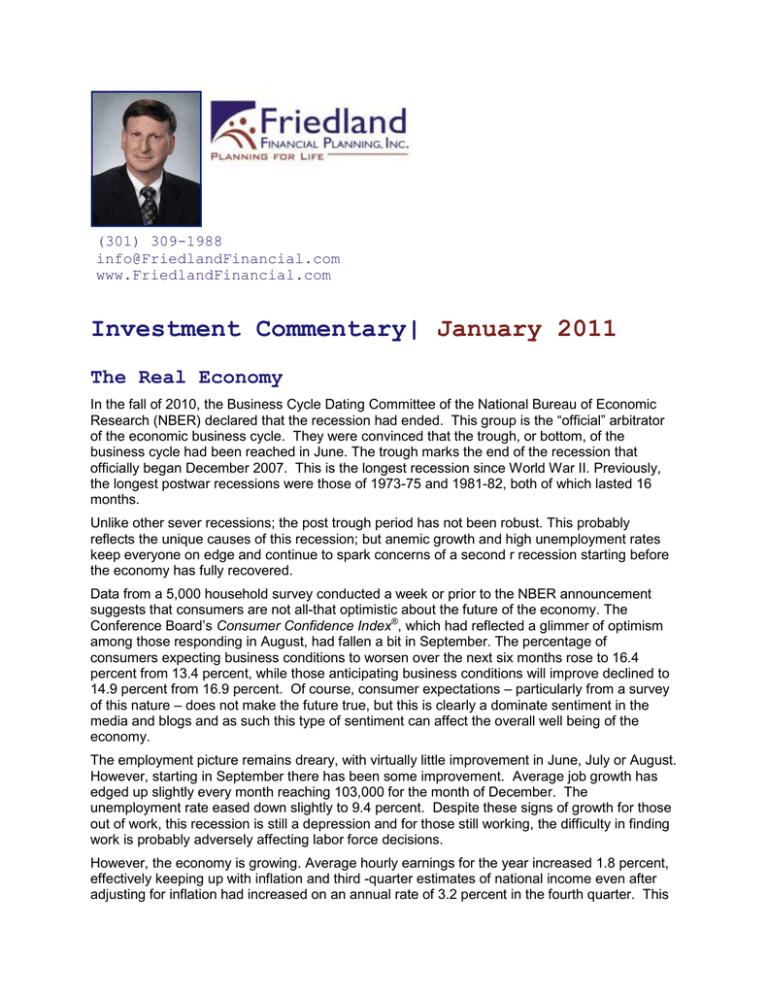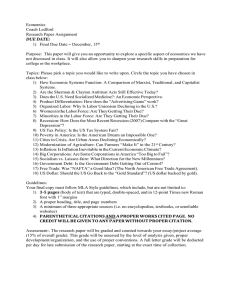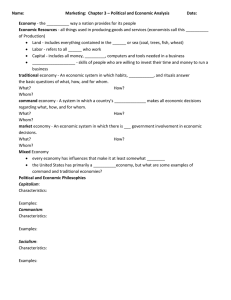
(301) 309-1988
info@FriedlandFinancial.com
www.FriedlandFinancial.com
Investment Commentary| January 2011
The Real Economy
In the fall of 2010, the Business Cycle Dating Committee of the National Bureau of Economic
Research (NBER) declared that the recession had ended. This group is the “official” arbitrator
of the economic business cycle. They were convinced that the trough, or bottom, of the
business cycle had been reached in June. The trough marks the end of the recession that
officially began December 2007. This is the longest recession since World War II. Previously,
the longest postwar recessions were those of 1973-75 and 1981-82, both of which lasted 16
months.
Unlike other sever recessions; the post trough period has not been robust. This probably
reflects the unique causes of this recession; but anemic growth and high unemployment rates
keep everyone on edge and continue to spark concerns of a second r recession starting before
the economy has fully recovered.
Data from a 5,000 household survey conducted a week or prior to the NBER announcement
suggests that consumers are not all-that optimistic about the future of the economy. The
Conference Board’s Consumer Confidence Index®, which had reflected a glimmer of optimism
among those responding in August, had fallen a bit in September. The percentage of
consumers expecting business conditions to worsen over the next six months rose to 16.4
percent from 13.4 percent, while those anticipating business conditions will improve declined to
14.9 percent from 16.9 percent. Of course, consumer expectations – particularly from a survey
of this nature – does not make the future true, but this is clearly a dominate sentiment in the
media and blogs and as such this type of sentiment can affect the overall well being of the
economy.
The employment picture remains dreary, with virtually little improvement in June, July or August.
However, starting in September there has been some improvement. Average job growth has
edged up slightly every month reaching 103,000 for the month of December. The
unemployment rate eased down slightly to 9.4 percent. Despite these signs of growth for those
out of work, this recession is still a depression and for those still working, the difficulty in finding
work is probably adversely affecting labor force decisions.
However, the economy is growing. Average hourly earnings for the year increased 1.8 percent,
effectively keeping up with inflation and third -quarter estimates of national income even after
adjusting for inflation had increased on an annual rate of 3.2 percent in the fourth quarter. This
follows a third quarter rate of increase of 2.6 percent. Real economic growth in excess of 3
percent will eventually result in a decline in the unemployment rate.
Financial Markets
For most of the year, the financial markets mirrored the real markets. After strong gains in July,
stocks reversed sharply in August, continuing a tug-of-war pattern that has characterized equity
returns through most of the year. However, a strong fourth quarter rally, punctuated by a
December sprint, turned an okay year into a good year for stocks.
The large-cap Vanguard 500 Index gained
nearly 11% for the quarter, and ended
2010 up nearly 15%. The small-cap
iShares Russell 2000 and iShares Russell
Midcap both returned in the mid teens in
the fourth quarter, and gained 27% and
25% for the year, respectively. Looking
abroad, the story was similarly positive for
emerging markets, with the Vanguard
Emerging Stock Index climbing 7.5% in the
quarter and 19% for the year. Developedmarket foreign stocks also had a good
year, but returns for the benchmark
Vanguard Total International Stock Index
were restrained by concerns over Greece’s
fiscal problems earlier in the year and
Ireland’s later in the year, which drove the
euro (and therefore returns to U.S.
investors) lower. The Vanguard Total
International Stock Index nevertheless
gained a healthy 7% in the fourth quarter
and 11% for the year.
As appropriate, for purposes of
diversification, the story about fixed income differed. The Vanguard Total Bond Market Index
Fund, for example, a proxy for high-quality intermediate-term bonds, saw most of its 1.4%
fourth-quarter loss come in December. Still, its strong performance earlier in the year left it with
a full-year gain of just over 6%. Foreign bonds also struggled through the fourth quarter, with the
Citigroup World Government Bond Index falling 1.8% and the emerging-markets JPMorgan
GBI-EM Global Diversified Index down 0.4%. Each index was in the black for the year, with
emerging market debt returning a notable 16%.
Connecting the Dots
The recent strength in the stock market along with a gradual improvement in the economy
should not lull us into a state of complacency. Though the economy is improving at the margin
and could exhibit stronger growth in 2011, structural risks remain. Here is a list of our concerns
that connect the real with the financial markets.
2
Household Debt Levels
1. Debt-level trends: Household measured from the perspective of the economy has declined
dramatically. However, much of the decline was due to defaults.
2. The cost to service debt and other financial obligations: The cost of servicing debt has
declined, despite the decline in income, in part because the cost of borrowing money has
fallen or loans that might have been made in the past were not being made. Stricter access
to credit and low interest rates are not likely to last and hence this ratio is likely to increase.
3. The overall level of debt: Unfortunately despite a meaningful reduction, the overall level of
household debt remains very high relative to disposable income. See the figure to your
right.
The Weak Labor Market
Jobless claims for unemployment insurance are declining, which suggests that layoffs may have
peaked. But job growth is anemic. Since December 2009 about 86,500 jobs have been created
on average per month. Over the last three months (through November) the average has been
even lower at just over 60,000. This
compares to about 100,000 jobs
needed per month just to keep pace
with growth in the labor force.
Although this may end up being
temporary, job growth for the first time
since the recession started exceeded
100,000 this past December. Other
measures of employment are improving
but remain dismal. There are about 4.2
job seekers per available job opening.
Even more disconcerting has been the
duration of unemployment for most
workers. Of the total unemployed, 42%
have been out of work for at least 27
weeks.
The Housing Market
In recent months home prices have slid
backwards in many markets. If house
prices decline too much, banks might
have to raise additional capital which would negatively impact the availability of credit. There
are a number of signs that suggest housing prices in many areas will fall more before they rise.
This is because a significant number of homes are “worth” less than their mortgage, jobs are still
precarious, and the number of homes for sale on the market has increased dramatically relative
to the number of home buyers on the market. While housing prices are very local; credit
markets are not.
3
U.S. Government Debt
While deficit spending is necessary to spur economic growth, gross federal debt is pushing
100% of GDP and state and local debt is another 20%. At some point the cost of servicing this
debt begins to eliminate the economic advantages of adding more debt. We are not at that
point yet, but in many countries this level of debt would be too much. This is clearly playing out
on the political stage and while reducing the debt in the long run will be good, moving too
quickly or in the wrong way can undermine the advantages of the countercyclical spending that
does occur. Very often, politics does not make for good policy and we worry a lot about the
tone of this discussion (even if the tragic shootings in Arizonia do change the nature of the
words, this political inflection in inherent in the reality of a split Congress and a forthcoming
Presidential Election).
State and Municipal Government Debt
While state tax collections have risen, State and local governments are often fiscally strapped.
Since property taxes are explicitly tied to property values, this source of revenue is down, as is
taxes from income and sales. Overall, state and local governments are not expected to
contribute to any improvement in the labor markets in 2011 and will continue to face long-term
structural problems from past spending decisions. It seems probable that there could be an
increase in local government debt defaults though it does not appear likely that these will be
widespread. They will generate headlines though, and that may trigger temporary sell-offs in the
municipal bond market. Recent talk among members of Congress of allowing state and local
governments to declare “bankruptcy,” however has increased the cost to state and local
governments of borrowing. While the rising cost of borrowing is good for lenders (i.e., investors)
it is not good for the state and local governments and in fact could help to bring about a default
that might not otherwise had occurred!
Debt Concerns Abroad
The weakness in Europe’s periphery continues to create enormous uncertainty. Most of the
southern European economies are uncompetitive and either have too much debt, high deficits,
or both, amounting to a longer-term solvency issue for some. Many of these countries can’t
devalue their currencies to increase their global competitiveness. Moreover, many have begun
to institute fiscal austerity programs that will be a drag on their economic growth.
As a byproduct, the European banking sector remains stressed with lots of short-term debt that
must be rolled over, fewer lending sources, rising rates, and more loan losses to come. At
present, they don’t have enough capital to handle a sovereign default. Fortunately a default in
the near term seems unlikely given European and IMF efforts, though eventually defaults by
Greece, Portugal, and Ireland would not be at all shocking. Spain is particularly important in
assessing the risks to Europe, given the size of its economy. A key concern is whether Europe
will have to bail out the Spanish banking sector.
While our bet is that Europe will muddle through, it is the region of the world that seems most at
risk for falling back into recession. While a recession in Europe will not necessarily trigger a
recession here, in the extreme it could and in the best of all situations it could further stifle our
anemic growth.
4
Emerging Markets
A new worry is the economic strength in many emerging markets. The problem is not that the
economies are strong, but rather that in a number of cases, policies to prevent their currencies
from appreciating (and hurting their export competitiveness) necessitate low interest rates that
can ignite inflation and asset bubbles. Inflation in China is the most visible problem and it is
already driving a tightening of monetary policy and fears that this will cause growth to slow too
much.
Outlook
While we often have to view the world from macroeconomic prism (because of the way in which
national data is collected and reported) this prism is biased in a negative way. When we take
off these glasses we can see that overall, the global economy did generate a reasonably
healthy level of growth in 2010—with most coming in the developing world. Things are slowly
getting better on many fronts. Emerging markets are exporting and growing. In the United
States, the corporate sector has record cash levels (though debt levels are also high) so it is in
a good position to hire and invest more when confidence improves. Capital investment is
already beginning to strengthen. Profits have been better than expected as companies have
aggressively cut costs and benefited from lower interest rates and low wage growth. Trade flows
have been strong and the United States has benefited. The recent tax bill maintains some of the
fiscal stimulus including extended unemployment insurance and reduced payroll taxes. Though
this adds to the deficit these polices could buy more time for the economy to gain momentum.
Finally, given the excess capacity and timid demand, interest rates and inflation are likely to
remain low for the next year or so. This may continue to lure investors back into a risk-taking
mode. While the risk of entrepreneurs is likely to be a positive, the risk taken by investors in the
secondary markets (you and me) could cause speculative bubbles.
How to invest in this market
We talk to lots of folks who just do not know what to do. For those still in the accumulation
phases of their careers, our advice is to keep on saving and to save regularly. Given the ups
and downs it would make sense to save smaller amounts on a weekly basis rather than larger
amounts on a monthly basis.
How to minimize Bad Decisions
Asset allocation, diversification, inflation rates, and “luck” are all critical aspects of how well your
portfolio will do in the longer run. There is a lot you can do about the first two factors and of
course there are some things you can do in response to changing price levels, but luck is just
that, luck. The critical aspect of luck is the timing and sequencing of selling when you are using
your savings to finance retirement. But often, as research on investment decision making has
demonstrated, the timing and sequencing of investment decisions while you are saving can also
affect your returns. Regardless of your investment strategy, consistency of implementation is
critical. Otherwise we become prone to biased decision making. When either fear of loss or
greed of gain dominate your decision making than you are no longer being systematic and this
is when most investors end up confounding their luck by buying after prices have increased and
selling after prices have fallen.
The single largest controllable factor in investment returns is your asset allocation. History
teaches us that there is an optimal asset allocation for both different time horizons and
tolerances for risk. Although there are different approaches to estimating these portfolios, they
are, of course, based on what we have observed in the past about the correlation of different
5
asset classes. In the absence of an alternative strategy, recommend that most investors try and
maintain their optimal asset allocation.
However, over the course of the business cycle, which may be 2-3 years, relative asset prices
shift. After all, the fact that there is a cycle, reflects different degrees and types of economic
activities – in a relative sense, and what happens in the real economy does affect the financial
markets. Hence, for those with relatively long time horizons and the interest and tolerance for it,
one could be tactical about asset allocations over the course of the business cycle by directing a
small portion of your long-term portfolio into asset classes that appear, from a historical
perspective, to be underpriced and avoiding asset classes that appear to be overpriced.
Such a tactical asset allocation is easier to achieve when you are regularly investing new funds.
By adding relatively more to an asset class that is underpriced and reducing your regular
savings into an asset class that is over priced, you can increase your expected rate of return
without dramatically increasing the likely risk.
Asset Class Return Estimates
The following table summarizes our current estimates of the annualized returns over the next
four to five years, by financial asset class using extremely different assumptions about
economic growth and inflation.
Financial
Asset Class
Average Annual Expected Rate of Growth
over the Next 4-5 Years
Hypothetical Scenarios
Another
Anemic
Stagflation
Recession
Growth
Optimistic
Recovery
Equities
U.S. Equities
Developed International
Emerging Markets
(4.1)%
(4.0)%
(3.0)%
(2.4)%
(2.3)%
(0.5)%
2.7%
1.9%
5.0%
10.7%
10.0%
13.2%
1.7%
2.6%
1.4%
0.8%
1.1%
3.4%
5.8%
5.0
1.1%
3.9%
1.7%
4.0
1.1%
4.6%
1.7%
6.0
(3.2)%
2.0
0.7%
3.0
(2.2)%
2.5%
0.4%
4%
Bonds
Investment-Grade Bonds
High-Yield Bonds
TIPS
Emerging Market Bonds
Alternatives
REITs
Arbitrage Strategies
Of these four scenarios, we are the most comfortable at this time with the Anemic Growth
assumptions. The overwhelming macroeconomic signs are more in favor of recovery than
recession and with so much excess capacity, it is hard to imagine any significant inflation.
This rules out the first two scenarios. Recent estimates of national income, corporate profits,
productivity, and employment are not consistent with a strong recovery making the fourth
scenario too optimistic.
6
Our best guess is that we will realize a scenario slightly better than the Anemic Growth outlined
above.
About Friedland Financial Planning
We do not sell products or accept referral fees of any type. This way you can be sure that our
recommendations are made for your benefit. We do not require that we manage your
investments, but we can either directly, or in partnership with you. If you would like to know
more, please give us a call. There is no charge for the initial consultation.
We Help Families Plan for Life
Investment advice is based on research done in conjunction with our research partner Litman/Gregory Analytics.
Certain material used is proprietary to and copyrighted by Litman/Gregory Analytics but is used by Friedland
Financial Planning, Inc. with permission. Reproduction or distribution of any portion of this Commentary is prohibited
and all rights are reserved.
©Friedland
Financial Planning, Inc. January 25, 2011
7









